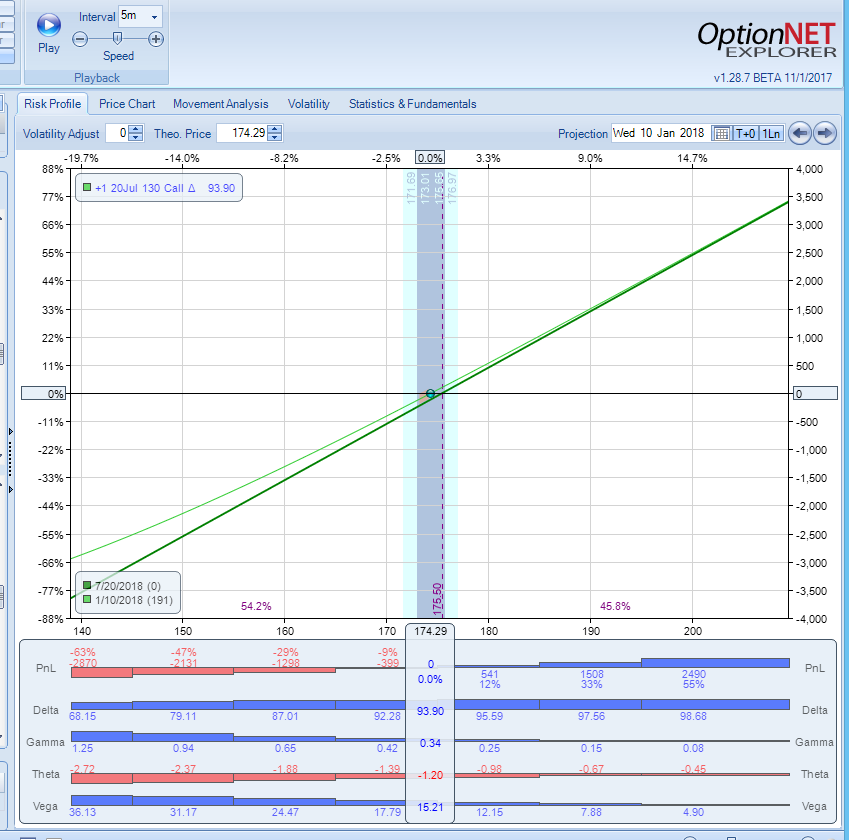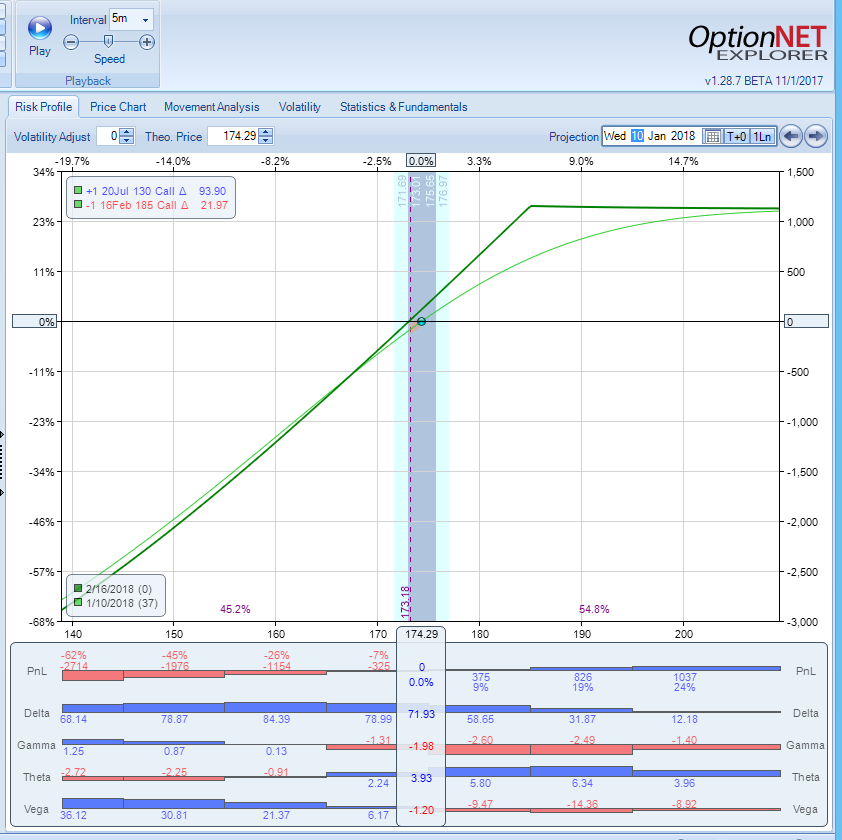
.thumb.jpg.423c1b7a9324babf04f010dd69030e10.jpg)
Stock replacement is an investment strategy that attempts to replicate the returns of a certain asset or group of assets by using a combination of different derivatives rather than buying the individual shares in the market.
This options investment strategy involves buying "Deep In The Money" (DITM) options to limit downside risk while retaining the full benefits of the stock. The options are purchased at a lower cost than the actual stock but still receive close to a $1 increase for every favorable $1 move in the underlying security which increases the percentage return for the same dollar move.
Advantages of stock replacement strategy:
WE RECOMMEND THE VIDEO: Best Binary bot.
The bot works so great. If you are interested in getting this bot. Contact me through my email remedytony@gmail. Com.
- Keeps all benefits associated with trading the stock.
- Reduces costs associated with owning the stock.
- Offers more leverage by increasing the potential percentage return.
- Offers lower downside risk.
Disadvantages of a stock replacement strategy:
- Needs good trading experience and skills to master the strategy.
- The strategy may fail, when the stock stays on (almost) the same price or moves sidewise.
- Leverage works both way - If the stock falls, the percentage loss is larger as well.
Let's check how you could use this options investment strategy to reduce your cost of owning Apple. The stock closed at $174 yesterday.
Experienced options traders are usually well aware of this strategy and make good use of it.
Strategy No. 1: Buy 100 shares of the stock
Buying 100 shares will cost you $17,400. Not cheap. If the stock rallies to $185, you have made $1,100 or 6%. Let's see how it compares with the stock replacement strategy.
Strategy No. 2: Buy DITM call
As an alternative to buying the stock, we can buy the AAPL July 20 2018 130 call at $45.47. The cost will be $4,547 which is about 26% of the cost of the 100 shares. The P/L graph looks like this:

If the stock rallies to $185, you have made $1,030. This is slightly less than buying the stock, but percentage wise, it is a 23% gain, compared to the 6% gain when owning the stock. Of course the opposite is true as well - if the stock goes down, your percentage loss is much higher.
This is called leverage. It works both ways - you increase the reward if the stock rises and increase the risk if the stock falls.
However, if the stock falls, the volatility should increase which actually helps our option price because increased volatility can cause option prices to increase or not fall as fast. So basically even though we will gain $1 for every $1 the stock increases we will lose slightly less than $1 for every $1 the stock drops.
You might noticed that we gained only 93 cents for every $1 movement in the stock. This is due to the fact that the delta of the 130 call is 0.93. We could choose a call which is deeper in the money - it would have a higher delta and have a better replication of the stock movement. However, it would also be more expensive and provide less leverage. 0.90-0.95 delta provides a good compromise between 1:1 movement and a reasonable price.
Now let's see if we can do better.
Strategy No. 3: Buy DITM call and sell OTM call against it every month
Here is how it works:
- Buy AAPL July 20 2018 130 call at $45.47
- Sell AAPL Feb 16 2018 185 call at $1.55
We reduce the cost of our trade by $155 to $4,392, but we also limited our gains. The P/L graph looks like this:

As we can see, we increased the maximum gain to $1,147. This gain is not only larger than the dollar gain from owning the 100 shares of the stock, but also translates to a cool 26% in one month. If the stock is below $185 by February expiration, we can repeat the process with the March options. If it is higher, you just close the trade for a gain and can roll to higher strikes.
Of course if you believe that AAPL will be higher than $185 by Feb expiration, you will be better by just buying the DITM calls.
Strategy No. 4: Buy DITM call, sell OTM call and buy OTM put
Here is how it works:
- Buy AAPL July 20 2018 130 call at $45.47
- Sell AAPL Feb 16 2018 185 call at $1.55
- Buy AAPL Feb 16 2018 165 put at $2.07
Our cost now is $4,599, still significantly lower than owning the stock. The P/L graph looks like this:

Our gain is now limited to "only" $900 (20%), BUT we also limited our loss to
13% in case AAPL goes down after earnings. And if the stock really crashes, the position can actually produce some gains because at some point the long put will more than offset the losses from the long call.
This is a variation of collar, where we replace the long shares with DITM call.
And this is the beauty of options. You have almost endless possibilities to structure your trade, based on your outlook and risk tolerance.
Before investing any money, please make sure you understand what you are doing. Good luck.
What Is SteadyOptions?
Full Trading Plan
Complete Portfolio Approach
Diversified Options Strategies
Exclusive Community Forum
Steady And Consistent Gains
High Quality Education
Risk Management, Portfolio Size
Performance based on real fills
Non-directional Options Strategies
10-15 trade Ideas Per Month
Targets 5-7% Monthly Net Return
Recent Articles
Articles
Pricing Models and Volatility Problems
Most traders are aware of the volatility-related problem with the best-known option pricing model, Black-Scholes. The assumption under this model is that volatility remains constant over the entire remaining life of the option.
By Michael C. Thomsett, August 16

- Added byMichael C. Thomsett
- August 16
Option Arbitrage Risks
Options traders dealing in arbitrage might not appreciate the forms of risk they face. The typical arbitrage position is found in synthetic long or short stock. In these positions, the combined options act exactly like the underlying. This creates the arbitrage.
By Michael C. Thomsett, August 7

- Added byMichael C. Thomsett
- August 7
Why Haven't You Started Investing Yet?
You are probably aware that investment opportunities are great for building wealth. Whether you opt for stocks and shares, precious metals, forex trading, or something else besides, you could afford yourself financial freedom. But if you haven't dipped your toes into the world of investing yet, we have to ask ourselves why.
By Kim, August 7

- Added byKim
- August 7
Historical Drawdowns for Global Equity Portfolios
Globally diversified equity portfolios typically hold thousands of stocks across dozens of countries. This degree of diversification minimizes the risk of a single company, country, or sector. Because of this diversification, investors should be cautious about confusing temporary declines with permanent loss of capital like with single stocks.
By Jesse, August 6

- Added byJesse
- August 6
Types of Volatility
Are most options traders aware of five different types of volatility? Probably not. Most only deal with two types, historical and implied. All five types (historical, implied, future, forecast and seasonal), deserve some explanation and study.
By Michael C. Thomsett, August 1

- Added byMichael C. Thomsett
- August 1
The Performance Gap Between Large Growth and Small Value Stocks
Academic research suggests there are differences in expected returns among stocks over the long-term. Small companies with low fundamental valuations (Small Cap Value) have higher expected returns than big companies with high valuations (Large Cap Growth).
By Jesse, July 21

- Added byJesse
- July 21
How New Traders Can Use Trade Psychology To Succeed
People have been trying to figure out just what makes humans tick for hundreds of years. In some respects, we’ve come a long way, in others, we’ve barely scratched the surface. Like it or not, many industries take advantage of this knowledge to influence our behaviour and buying patterns.

- Added byKim
- July 21
A Reliable Reversal Signal
Options traders struggle constantly with the quest for reliable reversal signals. Finding these lets you time your entry and exit expertly, if you only know how to interpret the signs and pay attention to the trendlines. One such signal is a combination of modified Bollinger Bands and a crossover signal.
By Michael C. Thomsett, July 20

- Added byMichael C. Thomsett
- July 20
Premium at Risk
Should options traders consider “premium at risk” when entering strategies? Most traders focus on calculated maximum profit or loss and breakeven price levels. But inefficiencies in option behavior, especially when close to expiration, make these basic calculations limited in value, and at times misleading.
By Michael C. Thomsett, July 13

- Added byMichael C. Thomsett
- July 13
Diversified Leveraged Anchor Performance
In our continued efforts to improve the Anchor strategy, in April of this year we began tracking a Diversified Leveraged Anchor strategy, under the theory that, over time, a diversified portfolio performs better than an undiversified portfolio in numerous metrics. Not only does overall performance tend to increase, but volatility and drawdowns tend to decrease:
Saturday, 28 September 2019